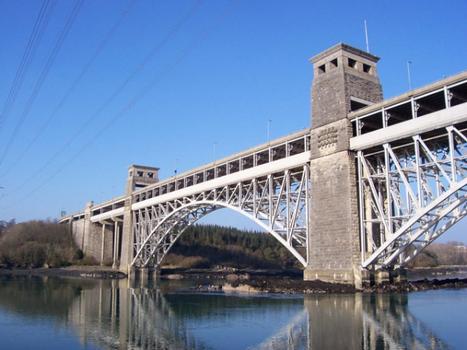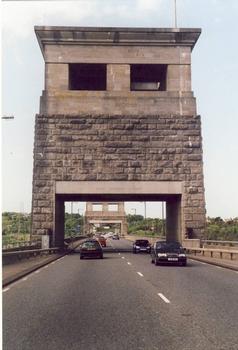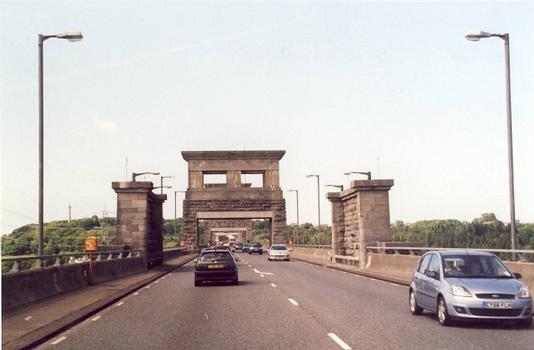General Information
Project Type
| Structure: |
Deck arch bridge |
|---|---|
| Function / usage: |
Railroad (railway) bridge Road bridge |
| Material: |
Steel bridge |
| Structure: |
Two-hinged arch bridge |
Awards and Distinctions
| 1966 |
for registered users |
|---|
Location
| Location: |
Bangor, Gwynned, Wales, United Kingdom |
|---|---|
| Crosses: |
|
| Replaces: |
Britannia Bridge (1850)
|
| Coordinates: | 53° 12' 57.97" N 4° 11' 8.33" W |
Technical Information
Dimensions
| total length | 432 m |
Materials
| arches |
steel
|
|---|
Chronology
| May 1970 | A fire severely damages the metal superstructure of the previous tubular bridge which is subsequently demolished. |
|---|---|
| 1971 | The demolished superstructure is replaced by arches. |
Excerpt from Wikipedia
Britannia Bridge (Welsh:Pont Britannia) is a bridge across the Menai Strait between the island of Anglesey and the mainland of Wales. It was originally designed and built by the noted railway engineer Robert Stephenson as a tubular bridge of wrought iron rectangular box-section spans for carrying rail traffic. Its importance was to form a critical link of the Chester and Holyhead Railway's route, enabling trains to directly travel between London and the port of Holyhead, thus facilitating a sea link to Dublin, Ireland.
Decades prior to the building of the Britannia Bridge, the Menai Suspension Bridge had been completed, but this structure carried a road rather than track; there was no rail connection to Anglesey prior to its construction. After many years of deliberation and proposals, on 30 June 1845, a Parliamentary Bill covering the construction of the Britannia Bridge received royal assent. At the Admiralty's insistence, the bridge elements were required to be relatively high in order to permit the passage of a fully rigged man-of-war. In order to meet the diverse requirements, Stephenson, the project's chief engineer, performed in-depth studies on the concept of tubular bridges. For the detailed design of the structure's girders, Stephenson gained the assistance of distinguished engineer William Fairbairn. On 10 April 1846, the foundation stone for the Britannia Bridge was laid. The construction method used for the riveted wrought iron tubes was derived from contemporary shipbuilding practices; the same technique as used for the Britannia Bridge was also used on the smaller Conwy Railway Bridge. On 5 March 1850, Stephenson himself fitted the last rivet of the structure, marking the bridge's official completion.
During March 1966, the Britannia Bridge received Grade II listed status.
A disastrous fire in May 1970 caused extensive damage to the Britannia Bridge. Following investigation, it was determined that the damage to the tubes was so extensive that they were not realistically repairable. It was decided to rebuild the structure in a quite different configuration, reusing the piers while employing new arches to support not one but two decks, as the new Britannia Bridge was to function as a combined road-and-rail bridge. The rebuild process was performed in phases, being initially reopened in 1972 as a single-tier steel truss arch bridge, carrying only rail traffic. Over the next eight years more of the structure was replaced, allowing for more trains to run and a second tier to be completed. The second tier was opened to accommodate road traffic in 1980. The bridge was subject to a £4 million four-month in-depth maintenance programme during 2011. Since the 1990s, there has been talk of increasing road capacity over the Menai Strait, either by extending the road deck of the existing bridge or via the construction of a third bridge.
Fire and reconstruction
During the evening of 23 May 1970, the bridge was heavily damaged when boys playing inside the structure dropped a burning torch, setting alight the tar-coated wooden roof of the tubes. Despite the best efforts of the Caernarfonshire and Anglesey fire brigades, the bridge's height, construction, and the lack of an adequate water supply meant they were unable to control the fire, which spread all the way across from the mainland to the Anglesey side. After the fire had burned itself out, the bridge was still standing. However, the structural integrity of the iron tubes had been critically compromised by the intense heat; they had visibly split open at the three towers and had begun to sag. It was recognised that there was still danger of the structure collapsing. As a consequence, the bridge was rendered unusable without the enactment of major restorative work.
In light of events, the chief civil engineer of British Railways' London Midland region, W.F. Beatty, sought structural advice from consulting engineering company Husband & Co. Following an in-depth investigation of the site performed by the company, it was determined that the cast iron beams inside the towers had suffered substantial cracking and tilting, meaning that the tubes required immediate support at all three towers. The Royal Engineers were quickly brought in to save the bridge, rapidly deploying vertical Bailey bridge units to fill the original jacking slots in the masonry towers. By the end of July 1970, a total of eight Bailey bridge steel towers had been erected, each being capable of bearing a vertical load of around 200 tonnes.
Further analysis showed that the wrought iron tubes had been too badly damaged to be retained. In light of this discovery, it was decided to dismantle the tubes in favour of replacing them with a new deck at the same level as the original tracks. With the exception of the original stone substructure, the structure was completely rebuilt by Cleveland Bridge & Engineering Company. The superstructure of the new bridge was to include two decks: a lower rail deck supported by steel arches and an upper deck constructed out of reinforced concrete, to carry a new road crossing over the strait. Concrete supports were built under the approach spans and steel archways constructed under the long spans on either side of the central Britannia Tower. The two long spans are supported by arches, which had not been an option for the original structure as a result of the clearance needed for tall-masted vessels; modern navigational requirements require much less headroom.
The bridge was rebuilt in stages. The first stage was to erect the new steel arches under the two original wrought-iron tubes. The arches were completed, and single-line working was restored to the railway on 30 January 1972 by reusing one of the tubes. The next stage was to dismantle and remove the other tube and replace it with a concrete deck for the other rail track. Then the single-line working was transferred to the new track (on the west side); this allowed the other tube to be removed and replaced with a concrete deck (which is used only for service access) by 1974. Finally the upper road deck was installed and by July 1980, over 10 years after the fire, the new road crossing was completed, and formally opened by the Prince of Wales, carrying a single-carriageway section of the A5 road (now the A55).
During 2011, a £4 million joint programme by national railway infrastructure owner Network Rail, Welsh Assembly Government and the UK Highway Agency, was performed upon the Britannia Bridge, aiming to strengthen the 160 year old structure and improve its reliability. The work involved the replacement of eroded steelwork, repairs to the drainage system, restoration of the parapets and stonework, and the painting of the steel approach portals of the bridge. A detailed inspection of the internal chambers of the three towers was performed, while a special walkway was also built to enable easier and safer access to the structure for future inspections of the masonry piers; special protective efforts adopted for the work included the use of special pollution-minimising paint and the decontamination of all equipment prior to being brought onsite.
Proposed bridge improvement
In November 2007, a public consultation exercise into the ‘A55 Britannia Bridge Improvement’ commenced. The perceived problems stated include:
- It is the only non-dual-carriageway section along the A55
- Congestion during morning and afternoon peak periods
- Congestion from seasonal and ferry traffic from Holyhead
- Queuing at the junctions at either end
- Traffic is expected to significantly increase over the next ten years or so
In the document, four options are presented, each with their own pros and cons:
- Do nothing. Congestion will increase as traffic levels increase.
- Widen existing bridge. To do this, the towers would have to be removed to make room for the extra lanes. This is an issue as the bridge is a Grade 2 listed structure and also as the bridge is owned by Network Rail. The extra lanes would have to be of reduced width as the existing structure is not capable of supporting four full-width lanes.
- New multi-span concrete box bridge alongside. Building a separate bridge would allow the existing bridge to be used as normal during construction. The bridge would require support pillar(s) in the Menai Strait, which is an environmental issue as the strait is a Special Area of Conservation. Visual impact would be low as the pillars and road surface would be aligned with the current bridge.
- New single span cable-stayed bridge. This would eliminate the need for pillars in the Strait, but the bridge would have a large impact on the landscape due to the height of the cable support pillars. This is also the most costly option.
Respondents were overwhelmingly in favour of seeing some improvements, with 70 percent favouring the solution of building a second bridge.
Text imported from Wikipedia article "Britannia Bridge" and modified on November 3, 2020 according to the CC-BY-SA 4.0 International license.
Participants
Relevant Web Sites
Relevant Publications
- (2017): Bridges. A History of the World's Most Spectacular Spans. 2nd edition, Black Dog & Leventhal, New York (USA), ISBN 978-0316507943, pp. 48-49.
- (1975): Britannia Bridge: Stress Investigation Before and after the Fire. In: Proceedings of the Institution of Civil Engineers, v. 58, n. 2 (May 1975), pp. 177-193.
- (1981): The Britannia Rail and Road Bridge in North Wales (United Kingdom). In: IABSE Structures, v. 5 ( 1981).
- Congestion threatens historic Britannia Bridge. In: Bridge Update, n. 72 (December 2007), pp. 2.
- (1975): Reconstruction of the Britannia Bridge. Part 1: Design. Part 2: Construction.. In: Proceedings of the Institution of Civil Engineers, v. 58, n. 1 (February 1975), pp. 25-66.
- About this
data sheet - Structure-ID
20005164 - Published on:
19/09/2002 - Last updated on:
05/02/2016








